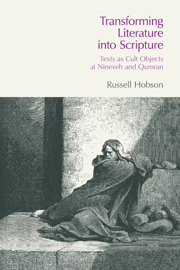Book contents
- Frontmatter
- Contents
- Acknowledgements
- Abbreviations
- 1 Authoritative Texts in the Hebrew and Cuneiform Traditions
- 2 Formulating a New Comparative Approach
- 3 Choosing the Right Texts
- 4 Study One: Enūma Anu Enlil Tablet 63
- 5 Study Two: Mul.Apin
- 6 Study Three: The Laws of Hammurabi
- 7 Study Four: Tablet XI of the Epic of Gilgamesh
- 8 Study Five: Mīs Pî
- 9 Study Six: Manuscripts of Pentateuchal Texts from Near the Dead Sea
- 10 Interpreting the Evidence
- Notes
- Bibliography
- Index of Ancient References
- Index of Authors
- Index of Subjects
3 - Choosing the Right Texts
- Frontmatter
- Contents
- Acknowledgements
- Abbreviations
- 1 Authoritative Texts in the Hebrew and Cuneiform Traditions
- 2 Formulating a New Comparative Approach
- 3 Choosing the Right Texts
- 4 Study One: Enūma Anu Enlil Tablet 63
- 5 Study Two: Mul.Apin
- 6 Study Three: The Laws of Hammurabi
- 7 Study Four: Tablet XI of the Epic of Gilgamesh
- 8 Study Five: Mīs Pî
- 9 Study Six: Manuscripts of Pentateuchal Texts from Near the Dead Sea
- 10 Interpreting the Evidence
- Notes
- Bibliography
- Index of Ancient References
- Index of Authors
- Index of Subjects
Summary
Defining Parallel Texts
Certainly the textual corpus of the ancient Near East is too vast to be subjected in its entirety to a rigorous analysis in the space available here. It is unavoidable that some compromise must be made between the constraints of space in the present study on the one hand, and the sheer volume of texts in the ancient Near Eastern corpus on the other.
The Historical Setting
As I outlined in the first chapter, I have restricted this investigation to cuneiform tablets from the first millennium bce. Texts will primarily be in Akkadian though some intermittent encounters with Sumerian will be inevitable. Texts written exclusively in Sumerian will not be considered.
The first-millennium bce cuneiform evidence examined here is primarily available from the Neo-Assyrian, Neo-Babylonian, and Late Babylonian periods, although occasional Seleucid period copies do exist. This means that our potential data covers the period from the middle of the eighth century bce to at least the late fourth century bce.
The Assyrian king Ashurbanipal (669–627 bce) is credited with instigating the large-scale collection and reproduction of cuneiform documents. Discoveries of large numbers of tablets at Kuyunjik, the main mound at Nineveh, were made during excavations by A. H. Layard, H. C. Rawlinson and H. Rassam. The excavations were undertaken from the middle to the end of the nineteenth century, and the recovered artefacts included many literary texts.
- Type
- Chapter
- Information
- Transforming Literature into ScriptureTexts as Cult Objects at Ninevah and Qumran, pp. 29 - 34Publisher: Acumen PublishingPrint publication year: 2012



